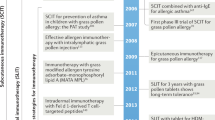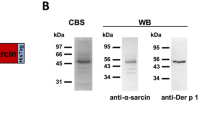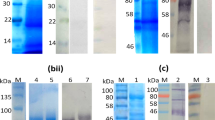Abstract
PASSIVELY sensitised chopped human lung fragments release mediators of immediate hypersensitivity when challenged with appropriate antigens1. Antigen triggers the release of mediators from mast cells or basophils by coupling of neighbouring surface IgE antibody molecules sharing the same antigen specificity2. Release of mediators should therefore be unlikely if specific IgE molecules are sparsely distributed on cell surfaces, as in normal non-allergic people, or if surface receptors are densely occupied by IgE molecules with other specificities. Humans harbouring certain parasites develop high IgE levels3, and epidemiological evidence suggests that allergic disorders such as hayfever or pollen asthma are rare in heavily parasitised populations4,5. It is not known whether IgE induced in man by parasite infestation is directed specifically against parasite antigens, or whether it represents nonspecific potentiation of IgE production against many different antigens, as demonstrated in the rat Nippostrongylus model6. Here we show that human lung fragments first exposed to IgE-rich serum from West African residents become resistant to further passive sensitisation with serum containing grass pollen-specific IgE.
This is a preview of subscription content, access via your institution
Access options
Subscribe to this journal
Receive 51 print issues and online access
$199.00 per year
only $3.90 per issue
Buy this article
- Purchase on Springer Link
- Instant access to full article PDF
Prices may be subject to local taxes which are calculated during checkout
Similar content being viewed by others
References
Sheard, P., Killingback, P. G., and Blair, A. M. J. N., Nature, 216, 283–284 (1967).
Levine, B. B., J. Immun., 94, 111–120 (1965).
Johansson, S. G. O., Mellbin, T., and Vahlquist, B., Lancet, i, 1118–1121 (1968).
Godfrey, R. C., Clin. Allergy, 5, 201–207 (1975).
Woolcock, A. J., and Blackburn, C. R., Aust. Ann. Med., 16, 11–19 (1967).
Jarrett, E. E. E., and Bazin, H., Nature, 251, 613–614 (1974).
Gleich, G. J., Averbeck, A. K., and Swedlund, H. A., J. Lab. clin. Med., 77, 690–698 (1971).
Rowe, D. S., et al., Bull. Wld Hlth Org., 43, 607–609 (1970).
Wide, L., Bennich, H., and Johansson, S. G. O., Lancet, ii, 1105–1107 (1967).
Ishizaka, T., Soto, C. S., and Ishizaka, K., J. Immun., 111, 500–511 (1973).
Stanworth, D. R., Clin. Allergy, 1, 25–35 (1971).
Ogawa, M., et al., Am. J. Med., 51, 193–199 (1973).
Ohman, J. L., and Block, K. J., J. Immun., 108, 1637–1646 (1972).
Jarrett, E. E. E., Orr, T. S. C., and Riley, P., Clin. exp. Immun., 9, 585–594 (1971).
Author information
Authors and Affiliations
Rights and permissions
About this article
Cite this article
GODFREY, R., GRADIDGE, C. Allergic sensitisation of human lung fragments prevented by saturation of IgE binding sites. Nature 259, 484–486 (1976). https://doi.org/10.1038/259484a0
Received:
Accepted:
Issue Date:
DOI: https://doi.org/10.1038/259484a0
This article is cited by
-
Allergy and worms: let’s bring back old friends?
Wiener Medizinische Wochenschrift (2014)
-
Nutritional status, intestinal parasite infection and allergy among school children in Northwest Ethiopia
BMC Pediatrics (2013)
-
A pilot screening of prevalence of atopic states and opisthorchosis and their relationship in people of Tomsk Oblast
Parasitology Research (2007)
-
IgE, allergies and helminth parasites: A new perspective on an old conundrum
Immunology & Cell Biology (1996)
-
Parasite-induced ‘nonspecific’ IgE does not protect against allergic reactions
Nature (1980)
Comments
By submitting a comment you agree to abide by our Terms and Community Guidelines. If you find something abusive or that does not comply with our terms or guidelines please flag it as inappropriate.



